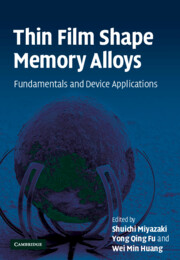Book contents
- Frontmatter
- Contents
- List of contributors
- Preface
- Abstracts of chapters
- 1 Overview of sputter-deposited TiNi based thin films
- 2 Martensitic transformation in TiNi alloys
- 3 Deposition techniques for TiNi thin film
- 4 TiNi multilayer thin films
- 5 Crystallization and microstructural development
- 6 Mechanical properties of TiNi thin films
- 7 Stress and surface morphology evolution
- 8 Ion implantation processing and associated irradiation effects
- 9 Laser post-annealing and theory
- 10 Overview of thin film shape memory alloy applications
- 11 Theory of SMA thin films for microactuators and micropumps
- 12 Binary and ternary alloy film diaphragm microactuators
- 13 TiNi thin film devices
- 14 Shape memory microvalves
- 15 Superelastic thin films and applications for medical devices
- 16 Fabrication and characterization of sputter-deposited TiNi superelastic microtubes
- 17 Thin film shape memory microcage for biological applications
- 18 Shape memory thin film composite microactuators
- 19 TiNi thin film shape memory alloys for optical sensing applications
- Index
6 - Mechanical properties of TiNi thin films
Published online by Cambridge University Press: 23 February 2010
- Frontmatter
- Contents
- List of contributors
- Preface
- Abstracts of chapters
- 1 Overview of sputter-deposited TiNi based thin films
- 2 Martensitic transformation in TiNi alloys
- 3 Deposition techniques for TiNi thin film
- 4 TiNi multilayer thin films
- 5 Crystallization and microstructural development
- 6 Mechanical properties of TiNi thin films
- 7 Stress and surface morphology evolution
- 8 Ion implantation processing and associated irradiation effects
- 9 Laser post-annealing and theory
- 10 Overview of thin film shape memory alloy applications
- 11 Theory of SMA thin films for microactuators and micropumps
- 12 Binary and ternary alloy film diaphragm microactuators
- 13 TiNi thin film devices
- 14 Shape memory microvalves
- 15 Superelastic thin films and applications for medical devices
- 16 Fabrication and characterization of sputter-deposited TiNi superelastic microtubes
- 17 Thin film shape memory microcage for biological applications
- 18 Shape memory thin film composite microactuators
- 19 TiNi thin film shape memory alloys for optical sensing applications
- Index
Summary
Abstract
This chapter is devoted to the mechanical properties of TiNi thin films. In this chapter, the shape memory behavior, two-way shape memory effect, superelasticity and stress–strain curves of sputter-deposited TiNi films are discussed with special attention to unique microstructures in Ti-rich TiNi films.
Shape memory behavior of TiNi thin films
TiNi bulk alloys are the most widely used shape memory alloys (SMA) in commercial applications [1] and their shape memory behavior has been well investigated (see Chapter 2). The development of SMA thin films, therefore, started with TiNi binary alloys [2, 3] and there are already many papers on the shape memory effect of TiNi thin films. Most work has been carried out on films attached to Si substrates from the viewpoint of practical application (see Chapter 8), but their shape memory behavior is severely affected by stress from the substrates. To understand the shape memory behavior of thin films themselves, study on freestanding films is essential [4, 5]. In this chapter, the shape memory behavior of freestanding TiNi films is discussed.
All the films in this chapter were sputter deposited on glass substrates and then peeled off the substrates before heat treatment. Unless the substrates are intentionally heated, as-sputter-deposited films are amorphous. Usually heat treatment above 773K is required to produce crystallization. This heat treatment provides us with an opportunity to control the structure of crystallized films and thus their shape memory behavior. The resulting shape memory behavior was evaluated by measuring the strain during cooling and heating under a constant stress. The specimens used for these measurements were typically 5mm long (gauge portion), 0.4mm wide and 7μm thick.
- Type
- Chapter
- Information
- Thin Film Shape Memory AlloysFundamentals and Device Applications, pp. 145 - 165Publisher: Cambridge University PressPrint publication year: 2009
- 2
- Cited by



